PERMACULTURE(?) HERE ON THE FARMDEN
True Accusation?
Accusations of my being a permaculturalist, that is, a practitioner of permaculture, are true, but only partially so. Yes, I grow peppers in a flower garden and persimmon as much for its beauty (see Landscaping with Fruit) as for its delicious fruits, also integrating other edibles right into the landscape. And, like permaculturalists, I do try to maximize use of the 3-dimensional space in my farmden with, for example, shade-loving black currants growing beneath my pawpaw trees.
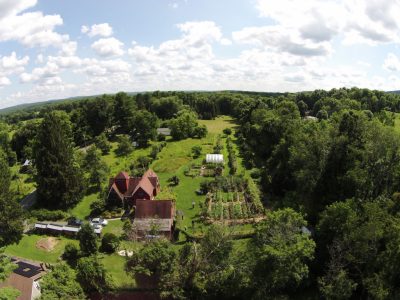
I am also a permaculturalistic in maintaining the integrity of my soil by not tilling it or otherwise disrupting the structure that builds up naturally in undisturbed soils. New ground is prepared for planting by merely smothering existing mowed or stomped down vegetation. I mulch with compost, leaves, wood chips and other organic materials to keep bare ground from ever showing.
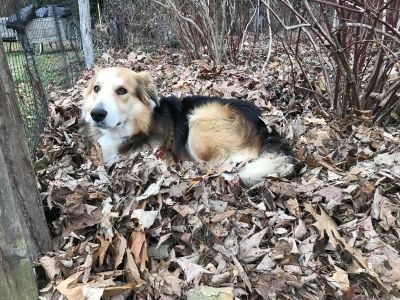
And like permaculturalists, I try to grow plants adapted to the setting so as to minimize pest problems. And poultry — ducks here on the farmden — wander freely, except in the vegetable gardens, to minimize pest problems, to provide fresh eggs, to add to the bucolic atmosphere, and to provide entertainment. And, in the shade of a Norway spruce, a rack holds up oak logs from which pop out shiitake mushrooms. I could go on.
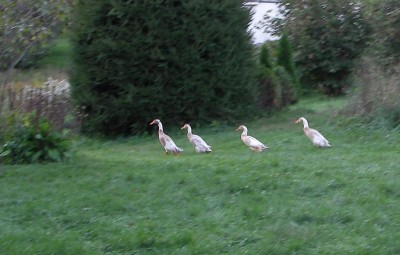
Why I Am Not a Full-Fledged Permy
Despite the assertion of one young, self-described “expert” permaculturalist, I am not a permaculturalist. I tend a permaculturesque farmden. Why the “-esque”? Because I part with true permaculturalists in a few critical ways.
Let’s begin with soil preparation. I smother existing vegetation beneath a few, typically four, sheets of newspaper topped with compost or some other weed-free, organic mulch. (I describe my methods in more detail in my book Weedless Gardening.) Many, perhaps most or all, permaculturalists prefer using corrugated cardboard from boxes as that first layer. The longevity of that cardboard on the ground is seen as an asset over paper. But I use paper so that soon after existing vegetation is smothered, the mulch and the soil below can begin to meld together. I don’t want any barrier to water and nutrients, or bacteria, fungi, earthworms, and myriad other soil organisms in place any longer than necessary.
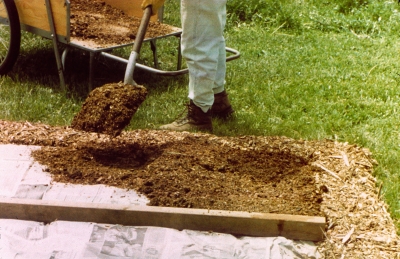
I part ways with permaculturalists by growing my vegetables rectilinearly, in straight rows within rectangular 3-foot-wide beds. Yes, the idea of organically shaped beds and keyhole gardens is very appealing –- on paper. But time, my time, is also an important element in the garden, and it takes a lot longer to maintain curved and somewhat randomly shaped bed than it does rectilinear beds.
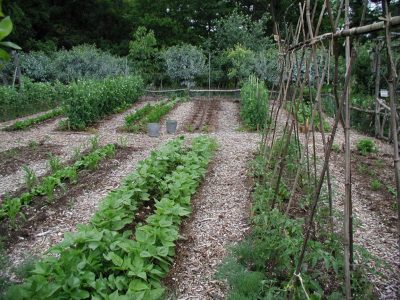
And then there’s the permy way of tucking, say lettuce plants, beneath fruiting shrubs and trees. But I eat a lot of vegetables and there’s nothing like straight rows running down straight beds for packing a lot of vegetables into a given area, and making planting, weeding, and harvesting quicker and easier. When I go out to pick some vegetables for a meal, I don’t want to be remembering where I tucked the lettuce and wending my way through trees and then crawling beneath some shrub to get at it.
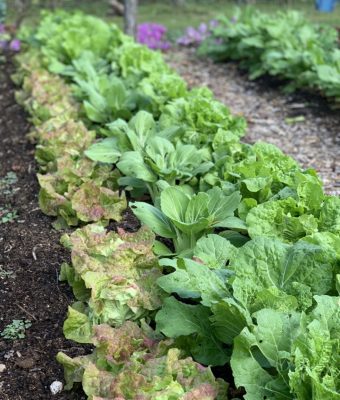
Permaculture originated and thrives in the dry climates of Australia and our Southwest. Over much of the country, and especially here in the Northeast, rainfall coaxes very exuberant growth from crop plants and weeds alike. Too many permaculturalists are liable to spend their first few permaculture years admiring their efficient and attractive use of space, and all the years hence cursing all the time needed cutting and weeding needed to keep growth of various plants in balance. What I need are some straight lines and a little elbow room.
(I have been hired more than once as a consultant on a property designed and planted by a true permaculturalist. I’m sure it looked great on paper and for the first few years, until it became a tangled mass of plants, more than most people could handle long term. Sometimes, the best course moving forward is to remove everything for a fresh, perhaps permaculturalesque start this time around. As one landowner told me, “a few years back I was ‘permacultured’ by some fine folks. I have been fighting my way back ever since.”)
“Forest gardening,” growing and eating from your planted forest, is receiving growing interest within permaculture circles. As you might guess, I’m also not a forest gardener, despite the fact that I have integrated fruiting trees, which do come from forests somewhere, as well as chestnuts, English walnuts, black walnuts, and other nutty things into my landscape.

Planted “forest”
I do have a miniforest in a portion of my meadow. The cool shade beneath the now large buartnut, shellbark hickory, maple, and river birch trees is not planted with herbs and vegetables for nibbling. It’s mostly a leafy mulch that fall in autumn, as in any forest floor. Oh, with a bow to forest gardening, I also planted ramps there.
I plant fruits, vegetables, and nuts to provide sustenance, not just a nibble here and there.
I Aim for Good Food, Not a Concept
I’m growing my own fruits and vegetables because I want great-tasting food. It seems to me that permaculture is usually about making growing plants easier. Nothing wrong with that, of course, except sometimes plants that are easiest to grow aren’t those that have the best flavor. I grow elderberries (back in my more hard-core permaculture planting along with aronia, rosa rugosa, seaberry, and highbush cranberry). Could anybody claim that a fresh picked elderberry can hold a candle to, flavorwise, a fresh picked blueberry?
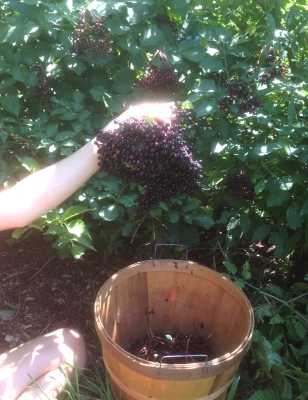
Elderberry harvest
Speaking of blueberry, they are easy to grow. But, if you want best production of flavorful berries, best to put some effort into getting the soil right, pruning correctly and annually, and netting to fend off birds so you can harvest truly ripe berries. Grapes? They need abundant sunlight, not the shady but easily supplied support of a nearby tree, for best quality and easy picking. Pruning is critical for topnotch flavor and pest control. It all takes effort, but is worth it.
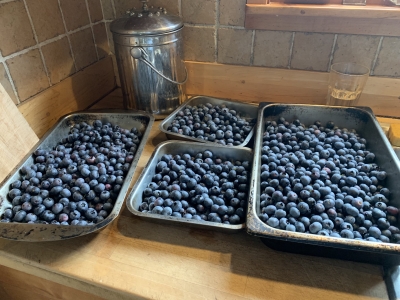
Today’s blueberry harvest
Although I am very intimate and knowledgeable about the plants I grow, I am no expert on permaculture. Perhaps I have misconstrued certain permaculture techniques or am totally missing the concept (even though I was accused of being a permaculturalist). I welcome feedback.


I appreciate this post and its honesty. I appreciate learning from permaculture practitioners though I don’t consider myself a permaculturist. I often wonder about it being used as an adjective as in “permaculture orchard”. I’m confused by what that means.
An open and honest question: What are the defining characteristics or practices that set apart a permaculture orchard from a “regular” orchard? And are those practices truly unique to permaculture?
Anyone out there care to chime in with specific ways in which this good question can be answered?
I part ways with permaculture when it strays into psuedoscience. There’s evidence that very thick sheet mulching with cardboard actually reduces oxygen in the soil, for instance: https://gardenprofessors.com/the-cardboard-controversy/ And there’s no particular evidence for many of its other claims, such as some plants functioning as biodynamic accumulators, or the vast majority of its ideas about companion planting.
I was initially very drawn to permaculture as it’s a lovely idea. Wouldn’t we all like to have endless amounts of healthy produce while living in perfect harmony with nature? It’s a fantasy of returning to some pre-industrial society where we might continuously harvest the majority of what we need from the land with minimum inputs and minimum disruption to the ecosystem. But the very idea of such a society in the vast majority of anthropological studies has been found to be just that, a fantasy.
That’s not to say that there is no wisdom to be found in traditional gardening practices: again, anthropology has found several examples of indigenous beliefs regarding planting, harvesting, or protecting the existence of wild sources of food that when tested, align with maintaining a sustainable food source.
But permaculture is hardly “traditional” — it is predominantly influenced by the “teachings” of people who came up with these concepts on their own. Determining cause and effect based on a sample size of your own personal experience (esp. when you are heavily biassed in favour of creating a new gardening paradigm) is not the best way to reach conclusions.
Not all “indigenous wisdom” pans out. Let’s not overly romanticize it.
I have been growing food for over 30 years, have several of your books, and now at 62 just completed my permaculture designer certificate through the in-depth online program at Permaculture Women’s Guild.
First, I would say that you, like many others I encounter, were introduced to permaculture in the garden at a very surface level and whoever ‘accused’ you does not have a solid foundation of the permaculture ethics and principles that form the holistic design system and if you let it, influences all levels of decisionmaking – both in the garden and outside of the garden. There are some permaculturists who are dogmatic in their thinking, and I hate to generalize but they tend to be older males!
Permaculture is based on the ways of nature and much of the initial wisdom of permaculture is rooted in the indigenous values about our relationship with and knowledge of nature. Basically, it’s about respect for the earth and those that live on it. Permaculture is about reducing our ecological footprint and increasing our communal footprint.
The permaculturists I know don’t have strict rules about how to do things – except to base our decision-making on the three care-based ethics, to observe the best conditions that create resilience for our lifestyles, our gardens, and our communities.
I use cardboard because that is what I have the most of. I live in a rural area with one newspaper that prints about 20 pages a week! I plant in straight rows because it serves my drip irrigation best. Keyhole gardens originated in Africa and there were good reasons to create those in the regions where they did.
I hate to hear that people were wrongly “permacultured” but like so much of our culture, people read a book, do a weekend workshop or watch youtube for a week and declare themselves an expert. In smart permaculture, we look at the conditions, the land, the weather, the people and the time, money, and energy, and then work with the ethics and design principles from the holistic design system of permaculture and design our gardens, our homesteads, our lives and our communities to be more resilient and empowered. That’s the permaculture I know and love!
I don’t disagree with most of what you wrote except for permaculture empowering our communities. That’s a very utopian view predicated on everyone having plenty of land; from what I’ve seen (and as I wrote) I have not seen yields of permaculture-grown gardens that could scale up to provide people with sustenance. I’d be interested in how much of a permaculturalist’s food actually comes from a local market.
It is hopeful rather than utopian. A lofty but rewarding goal. Permaculture that I have studied and practice is about building resilience for both individuals and their communities (defined loosely as family & friends, neighborhoods and entire communities, far less about gardening strategies. I am fortunate to be in a region that has a long history of agriculture but sadly, 92% of the food grown in my region is exported to mostly international markets. So a small group of folks started a non-profit with a mission to develop and support a locally grown food system and address the staggering 20% rate of food insecurity. The current ED is a permaculture designer who is focused on community resilience, not gardening strategies. Twenty years later, my region of rural small towns (pop. 75k) now hosts 8 farmer’s markets that accept only market growers, all who grow organically and love to talk about their soil as well their recipes for their produce. We actually had too many CSAs for a few years and now seem to have a balance of demand and supply. We have a new farmer’s collective that delivers to collections spot once a week. Our granges have been revitalized, hosting educational films and speakers about food and community. We have local ranchers who practice permaculture philosophy with regenerative practices, producing pastured beef, pork, chickens. We have orchards that now sell locally after years of exporting. With all this produce, we now have makers of local products like ferments, kombucha, pickles, fruit wines, and of course, our region is known for its micro beers and wineries. We even have several flower farmers who sell bouquets and are in demand for weddings. This is probably not a big deal to folks in your region where I have read that local food economies are strong. But to develop this in 20 years is remarkable. We have young farmers moving here and yes the land is expensive but our non-profit has been working with landowners and finding affordable leases for the farmers. Our market growers don’t talk about permaculture philosophy but they are committed to growing good food for their small communities which for me is the ultimate goal. Meanwhile, home growers like my newsletters which always include a permaculture topic for discussion. In January, I am starting a permaculture study group in my community that is open to anyone who wants to grow some of their food and contribute to our community’s resilience. And for the record: I would estimate that about 75% of my food is from local growers. Honey, eggs, meat, fruits, and early season greens are purchased from my neighbors and local growers. It’s a good model and it is rooted in the care-based ethics of permaculture.
It does sound utopian and, have to say, upscale. Kombucha, fruit wines, beer from microbreweries and pastured beef are not nourishment for low-income communities. Where are you located?
Love the statement “I Aim for Good Food, Not a Concept”.
Hi Lee,
Permaculture, schmeraculture – screw semantics. Your farmden, based on years of intelligent farming, is exemplary and inspiring.
Cardboard in my area is my preference, because it has a high likelihood of encouraging a fruiting of morchella importuna the following spring. I don’t know if there is anything more satisfying to grow!
Hmmmmm
I, too, was intrigued by the concepts of permaculture, and like you, I aim to grow good healthy food! I also love to build pollinator habitat, as it seems to be dwindling throughout the world…SO I planted fruit trees and brambles, and add lots of flowers. I,too, have moved back to rows versus blocks. I like the perfection of lines, and the weeding is most effortless. I mulch and feed, but often do not keep the ground covered as the soil tends to stay too cool in these crazy Adk summers, and the slugs and snails are ravenous!
Love your simplicity seasoned with science.
‘True’ Permaculture balances the social aspects and realities of any design. It’s not a stamp but is often used that way. If a design has become overgrown and not aligning with the steward then it’s a short coming of the author and not the practice.
Here’s my version of all this: The creek valley that leads to my village of Marcellus NY was once solid historic grapevines. Several appear on my property as part of the continues. There is one type in particular that always attracts Japanese beetles mid June. My sport is to collect those beetles off the vines 3 times a day, tapping them down into a container of water. Then I bring them out to our 5 chicken girls, into a big water bowl I have in their yard. Each one will eat about 30. Can you imagine what it feels like to have 30 crawling beetles in your crop? My chicken girls go for them immediately to see who will get the most. Now there’s a sustainable crop!